AMD AM1 Kabini Part 2: Athlon 5350/5150 and Sempron 3850/2650 Tested
by Ian Cutress on May 29, 2014 2:00 PM ESTCPU Synthetic Benchmarks
Content Creation - Cinebench
Based on MAXON’s CINEMA 4D animation software, Cinebench is used to determine the CPU and graphics performance via OpenGL. The software has gone through many iterations over the years, and here we use versions 10, 11.5 and 15 to compare single-threaded and multi-threaded CPU performance. As the generations increase, the software becomes more multithread aware and scales better, however for consistency with older results we keep the version 10 results in our database.
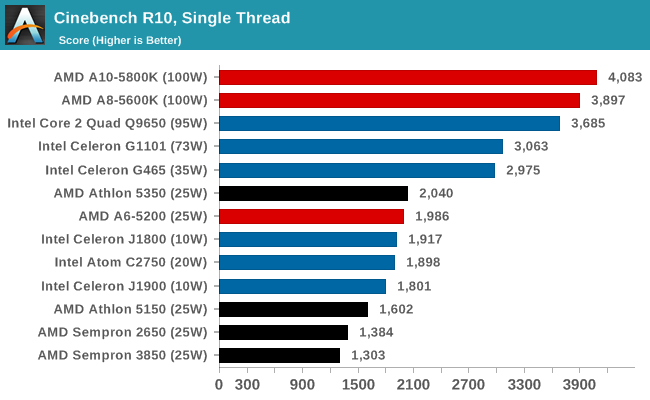
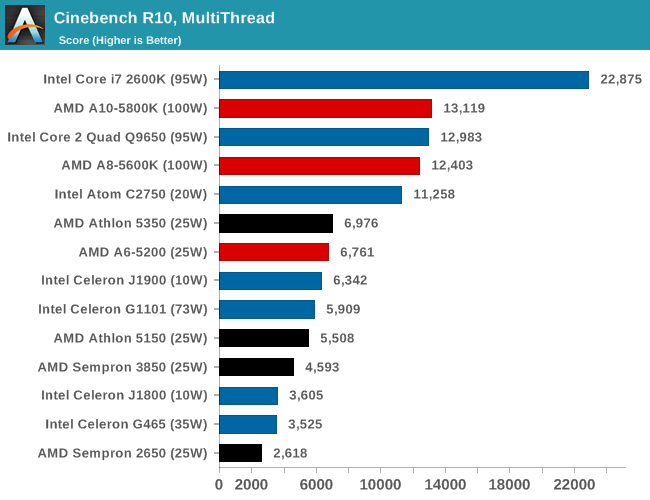
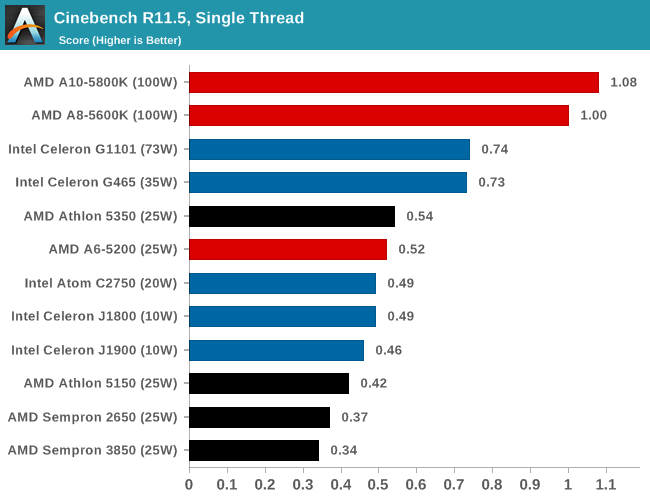
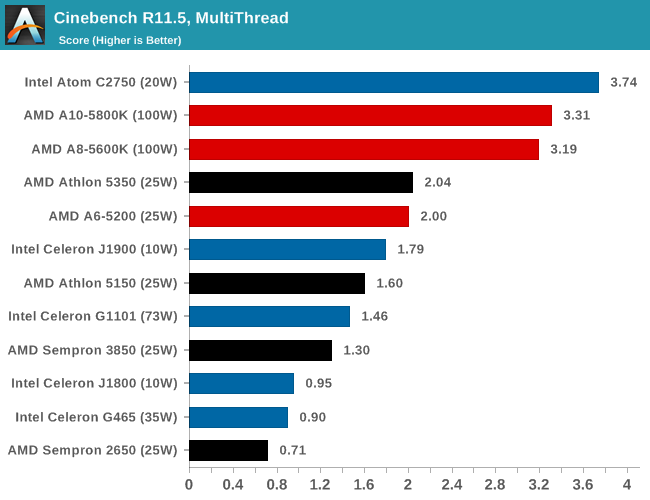
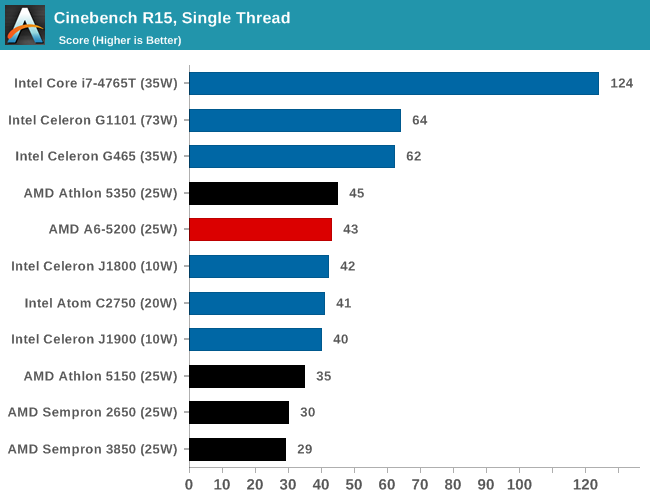
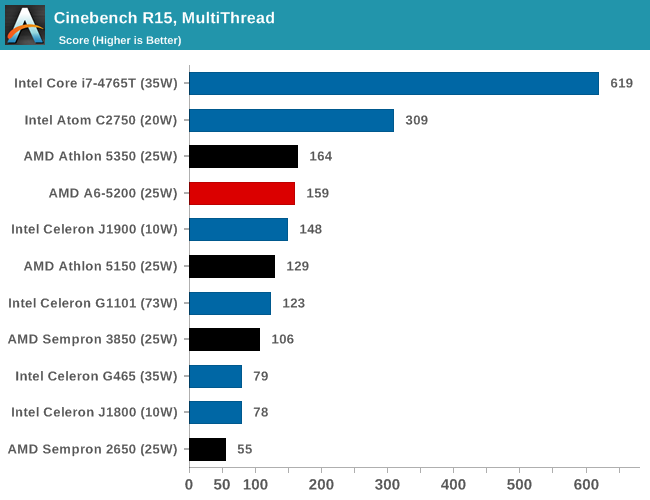
Synthetic – 7-Zip 9.2: link
As an open source compression tool, 7-Zip is a popular tool for making sets of files easier to handle and transfer. The software offers up its own benchmark, to which we report the result.
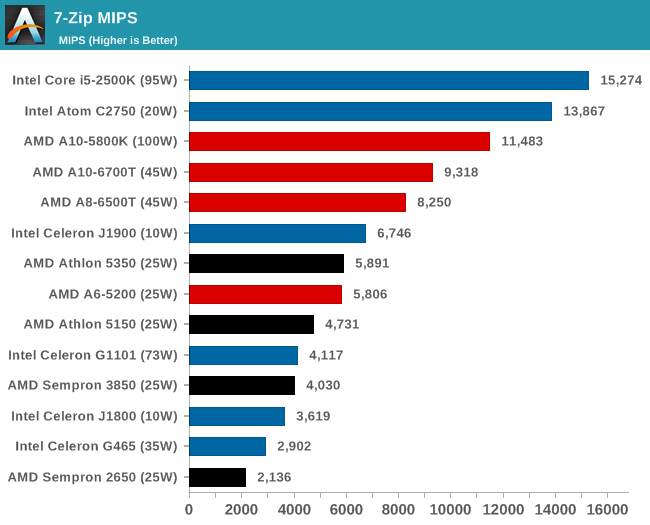
Rendering – PovRay 3.7: link
The Persistence of Vision RayTracer, or PovRay, is a freeware package for as the name suggests, ray tracing. It is a pure renderer, rather than modeling software, but the latest beta version contains a handy benchmark for stressing all processing threads on a platform. We have been using this test in motherboard reviews to test memory stability at various CPU speeds to good effect – if it passes the test, the IMC in the CPU is stable for a given CPU speed. As a CPU test, it runs for approximately 2-3 minutes on high end platforms.

Console Emulation –Dolphin Benchmark: link
At the start of 2014 I was emailed with a link to a new emulation benchmark based on the Dolphin Emulator. The issue with emulators tends to be two-fold: game licensing and raw CPU power required for the emulation. As a result, many emulators are often bound by single thread CPU performance, and general reports tended to suggest that Haswell provided a significant post to emulator performance. This benchmark runs a Wii program that raytraces a complex 3D scene inside the Dolphin Wii emulator. Performance on this benchmark is a good proxy of the speed of Dolphin CPU emulation, which is an intensive single core task using most aspects of a CPU. Results are given in minutes, where the Wii itself scores 17.53; meaning that anything scoring better than this is faster than an actual Wii for processing Wii code, albeit emulated.











87 Comments
View All Comments
Ian Cutress - Thursday, May 29, 2014 - link
I've taken test data from all of my old testing as well, where I've run the same benchmarks on the same OS and SSD, hence why there are many data points to choose from. I have adjusted several of the graphs to have a narrower band of data showing to more easily see the difference now. Unfortunately the even older data (pre Core 2) is before my time at AnandTech.Regarding the J1800/J1900 motherboards, the two that I hurried in for testing were unfortunately limited in the GPU aspect and a third one I have since received is also in the same boat. Due to the hurried nature of getting the data from the initial release (as well as other testing on hand) I had perhaps wrongly assumed that all J1800/J1900 motherboards were in the same boat.
I am shifting my test stations around somewhat this week, so when I come back from Computex I will have more of a low power/DRAM testing setup alongside the higher power systems I normally test. If you want to see anything specific, please feel free to email.
edwpang - Friday, May 30, 2014 - link
It's definitely makes better sense than current review. As someone has already, using 1250w PS on this low end setup is kindly uselessly.piroroadkill - Thursday, May 29, 2014 - link
Truecrypt link seems like a bad idea right now, since the official Truecrypt site is in a terrible state of limbo where nobody can figure out whether it's discontinued by the devs or been hacked. Benchmarks for 7.1a are relevant, but 7.2 is a gutted, useless pile of crap. Just saying.A5 - Thursday, May 29, 2014 - link
It's good thing the bench is 7.1a then?Ian Cutress - Thursday, May 29, 2014 - link
Ha! I thought about taking the data out given that I had already uploaded almost all it before that announcement was made. However 7.1a is still viable and I still have the installer, so it might still be relevant if the installer still floats around in cyberspace. I somehow doubt we will ever get a full explanation from the developers on why they took it down, though there are many theories about it.Runamok81 - Thursday, May 29, 2014 - link
Typo, second to last sentence. platgormsomeeeguy - Thursday, May 29, 2014 - link
Ian, in the "dGPU Benchmarks with ASUS HD7970" portion of your review, it would have been interesting to see some Mantle results on these low power CPUs.JBVertexx - Thursday, May 29, 2014 - link
I think the value in having a socket solution is less about providing an upgrade path and more about lower carrying costs in the entire supply chain.If you look at having 4 CPU combinations over lets say 4 motherboard options, having a BGA solution means that you need to source and stock 16 different items. With a socket solution, that cuts your inventory and carrying cost down to 8 items.
The economics of this are huge. It impacts motherboard manufacturers, system builders, and businesses. It impacts the amount of up front investment required by every organization in the supply chain, and it impacts the inventory costs (or carrying capital).
It especially impacts motherboard manufacturers, who must actually purchase the CPU in a BGA solution in order to sell a motherboard.
In the face of those compelling economics, having an upgrade path is really small potatoes.
marvee - Thursday, May 29, 2014 - link
The understanding of those economics could be the experience of Rory Read, from his time with Lenovo.Hrel - Thursday, May 29, 2014 - link
Pretty disappointing you guy didn't include a CPU with HD4600 on it in the gaming benchmarks. Why compare to last generation's hardware? Perhaps to show AMD in as favorable a light as possible? hmmmmm.....